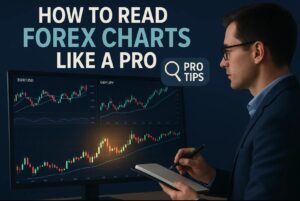How do beginners learn forex trading in 2025
Learning forex trading as a beginner can be a structured and rewarding journey if approached methodically. The foreign exchange (forex) market is the world’s largest financial market, where currencies are traded globally, offering vast opportunities but also requiring careful education and discipline. This comprehensive guide outlines how beginners can learn forex trading effectively, covering essential steps, strategies, and tips for success.
Understanding Forex Trading Basics
Forex trading involves buying one currency while simultaneously selling another, aiming to profit from changes in exchange rates. It operates 24 hours a day across different global financial centers, providing liquidity and flexibility for traders. Key concepts to grasp early include:
- Currency pairs: Forex is quoted in pairs, such as EUR/USD or GBP/USD, where the first currency is the base and the second is the quote currency.
- Pips and spreads: A pip is the smallest price move in a currency pair, while the spread is the difference between the bid and ask price.
- Leverage and margin: Leverage allows traders to control larger positions with a smaller amount of money, increasing both potential profits and risks.
- Market sessions: Understanding when markets in London, New York, Tokyo, and Sydney open and close helps in timing trades effectively.
Step-by-Step Guide for Beginners to Learn Forex Trading
1. Choose a Reliable Forex Broker
Selecting a trustworthy broker is the first critical step. Look for brokers regulated by reputable financial authorities, offering transparent fees, competitive spreads, and a user-friendly trading platform. Many brokers provide demo accounts and educational resources, which are invaluable for beginners to practice and learn without risking real money.
2. Open and Set Up a Demo Account
Before investing real capital, open a demo account to familiarize yourself with the trading platform and practice executing trades. This risk-free environment helps you understand order types, charting tools, and market dynamics. Demo trading builds confidence and allows testing of strategies without financial pressure.
3. Learn Forex Fundamentals and Terminology
Invest time in understanding forex market mechanics and terminology. Key areas include:
- How currency pairs work and what influences their prices
- Economic indicators (e.g., interest rates, employment data) and geopolitical events impacting currencies
- Technical analysis basics like chart patterns, indicators, and trend lines
- Fundamental analysis focusing on macroeconomic factors.
Utilize online courses, videos, and broker-provided educational content to build a solid foundation.
4. Develop a Trading Plan
A trading plan is essential for discipline and consistency. It should define your:
- Financial goals and risk tolerance
- Preferred trading style and strategies
- Rules for entry and exit points
- Risk management techniques, including position sizing and stop-loss levels
Sticking to your plan helps avoid emotional decision-making, which is a common pitfall for beginners.
5. Start with Major Currency Pairs
For beginners, focusing on major pairs like EUR/USD, GBP/USD, and USD/JPY is advisable. These pairs have high liquidity, tighter spreads, and more predictable price movements, making them easier to trade and analyze.
6. Learn and Practice Trading Strategies
Understanding and applying trading strategies is key to success. Some beginner-friendly strategies include:
- Trend Trading: Identifying and trading in the direction of prevailing market trends.
- Range Trading: Buying at support levels and selling at resistance within a price range.
- Breakout Trading: Entering trades when price breaks out of established ranges, signaling potential new trends.
- Swing Trading: Holding positions for several days to capture medium-term price moves.
- Scalping: Making quick trades to profit from small price changes, though this requires experience and focus.
Practice these strategies on your demo account to see which suits your style and risk appetite.
7. Execute Trades and Manage Risk
When confident, begin trading with real money but start small to manage risk. Use stop-loss orders to limit potential losses and take-profit orders to secure gains. Risk management is crucial; many experts recommend risking only 1-2% of your trading capital on any single trade.
8. Monitor and Review Your Trades
Regularly monitor your open positions and stay updated on market news and economic events. After closing trades, review your performance to identify what worked and what didn’t. Keeping a trading journal can help track your progress and refine your strategies over time.
9. Continue Learning and Adapting
Forex trading is a continuous learning process. Stay informed about market developments, explore advanced analysis techniques, and adapt your strategies as needed. Patience and persistence are vital since mastering forex trading can take months or years.
Tips for Forex Trading Beginners
- Educate Yourself Thoroughly: Invest time in learning market fundamentals and trading psychology.
- Make a Plan and Stick to It: Discipline is more important than intuition.
- Practice Diligently: Use demo accounts extensively before trading live.
- Manage Emotions: Avoid chasing losses or overtrading.
- Start Small: Scale your trading size as you gain experience.
- Choose the Right Broker: Ensure they offer good support, tools, and fair trading conditions.
How FXNovus Supports Beginner Forex Traders
As you begin your forex trading journey, choosing the right tools and educational support is just as crucial as learning the fundamentals. FXNovus stands out by offering a robust ecosystem tailored to beginner and intermediate traders alike. Here’s how it can help you accelerate your learning and improve your trading strategy:
1. Comprehensive Education Center
FXNovus provides a structured learning path through its extensive education portal:
- Introductory Courses: Includes beginner-friendly lessons on forex basics, trading terminology, economic fundamentals, ECNs, and MetaTrader tutorials.
- Advanced Lessons: Delves deeper into complex market strategies and economic principles.
- In-Depth Courses: Covers trading tools, CFDs and stocks, and effective trading strategies.
- eBook Library: Offers downloadable resources on trading psychology, capital management, market analysis, and technical strategies—ideal for learning at your own pace.
2. Economic Calendar
Stay informed with FXNovus’s real-time economic calendar:
- Track key market-moving events like GDP releases, inflation reports, and central bank decisions.
- Set up personalized filters and notifications to stay ahead of high-impact events.
- Understand how each economic indicator can influence currency pairs.
3. Trading Central Integration
FXNovus integrates Trading Central, an award-winning analysis suite, directly into its platform:
- Access technical analysis tools, including Panoramic View, Technical Score, and Alpha Generation features.
- Receive curated newsletters and updates on actionable market events.
- Use Technical Insight and Strategy Builder to validate trade ideas and create custom strategies with confidence.
4. Charting and Analytical Tools
Leverage real-time charts and key technical indicators to support your trading decisions:
- Identify key levels and trend directions using Trading Central’s visual tools.
- Analyze market conditions with confidence, whether you’re a visual learner or a data-driven trader.
By combining education, market insight, and powerful analysis tools, FXNovus empowers traders at every stage to make more informed and strategic decisions.
Conclusion
Learning forex trading as a beginner requires a structured approach: choosing a reliable broker, educating yourself on market fundamentals, practicing with demo accounts, developing a solid trading plan, and applying tested strategies with disciplined risk management. With patience and consistent effort, beginners can build the skills needed to navigate the forex market successfully and potentially achieve profitable trading outcomes.
This step-by-step roadmap, combined with ongoing education and self-review, forms the foundation for a sustainable forex trading journey.


